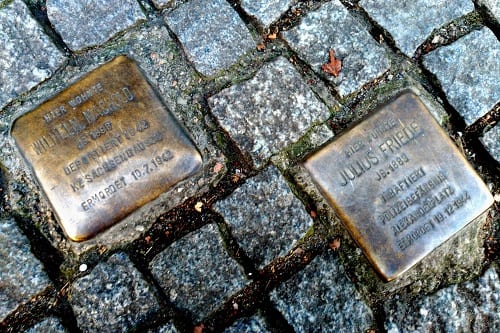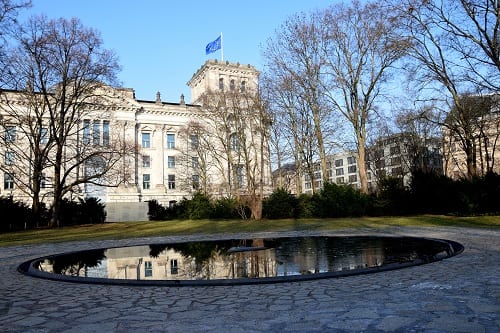A Stolperstein (“stumbling stone”) was going to be laid in the pavement in front of the building
where I worked. In addition to local residents, relatives of the person being commemorated on the Stolperstein were also planning to come from Israel.The Stolperstein project is an unparalleled art project that was initiated by Gunter Demnig, an artist from Cologne. The concept is actually quite simple.A brass covered stone bearing the name and the date of birth and death of a victim of the Nazi regime is lain in the pavement in front of the last place of residency that was freely chosen by that person.Anyone can participate in this project for €120. The participant is responsible for accurately investigating the family history of the victim and applying to the city and the construction bureau for a permit to install the stone in the street. They must then contact Demnig’s project team and set a time and date for installing the stone.The most common case is for a class in school to research and install a stone under the supervision of their teacher. The students learn about and confront the fate, life, and death of one individual. Through this process, one abstract victim becomes a real individual. The victims are no longer simply numbers.

This two stones I walk by quiet often.The first one is for Wilhelm Machold, a gay rights activist who was engaged in the Bund für Menschenrecht e.V which was founded in 1923, and advocated the rights of queer people. He was murdered in the concentration camp Sachsenhausen, close to Berlin, in 1942.The other one reminds Julius Friede, who married a jewish single mother. Later he supported the small resistance group „Gemeinschaft für Frieden und Aufbau“ which helped people into hiding.He was killed in 1944 while being held at a police station.
I think that the Stolperstein way of modest commemoration with a quiet memento is really wonderful. However, some people are opposed to Stolperstein. This is because they are paving stones, and so the memory of the victim will stepped on.January 27 is International Holocaust Remembrance Day aimed at remembering those lost to the Nazis.In 1996, January 27 was officially designated a memorial day for all of Germany as a day to remember the victims of Nazism. January 27 was the day the Red Army liberated Auschwitz-Birkenau and two other concentration camps in 1945. In 2005, this day was chosen as an international memorial day by the UN General Assembly.On this day, we remember the Jews, sexual minorities, Sinti and Romani people, communists, people with physical or mental disabilities, and others who were persecuted under the Nazi regime. The federal parliament also considers this a very important day and holds an extraordinary Cabinet meeting. This year’s extraordinary Cabinet meeting focused especially on victims of euthanasia, and two descendants of victims gave speeches on International Holocaust Remembrance Day.From 1939 to 1945, between 70,000 and 100,000 individuals with physical or mental disabilities were murdered in Nazi euthanasia programs. From 1933, another 400,000 men and women underwent forced sterilization, and 6,000 of them died in the procedure. This was the first time that this particular group of victims was given special focus by the parliament, and a speech was given by a young man with Down syndrome.The Memorial to the Murdered Jews of Europe located in the central political district near Brandenburg Gate is world-famous, but there are also smaller memorials for the murdered victims of euthanasia, for sexual minorities, for the Sinti and Romani people, and for others that you might not notice when passing by.

The biggest memorial site is the memorial for the murdered Jews of Europe, built in 2005.

If you cross the street from the Memorial for the murdered Jews, you will find the memorial for murdered homosexuals, a bit hidden in the park.
All of these memorials are always decorated with flower offerings. Large floral tributes from victims’ associations, the Federal Anti-Discrimination Agency, and each party are the most prominent.Something that concerns me is that the floral tributes to the memorial for Sinti and Romani victims are always the smallest. This is true even though this group still faces prejudice and discrimination around Europe today.

Organizations and political parties lay down flowers and wreaths in order to remember. The fewest flowers you will unfortunately find at the memorial for the murdered Sinti and Roma, but still, I think, this place where you can feel the silence is the most impressive one.
Critical debate is needed to discuss not only the memories of the victims, but also how their memorials are treated. People who take selfies in front of memorials should be putting more thought into the buildings they are posing in front of for photo sessions as mere backgrounds and to using those kinds of shots as their social media profile pictures.At the moment this topic is reaching a turning point. The trial last year may have been the last trials on the NS time. Hitlers “Mein Kampf” (My struggle) is in its’ commented edition a bestseller again, Germany’s supreme court rejected for the second time a proposed ban on the anti-semitistic Party NPD and in a lot of countries world wide right winged politics are growing stronger.


































































